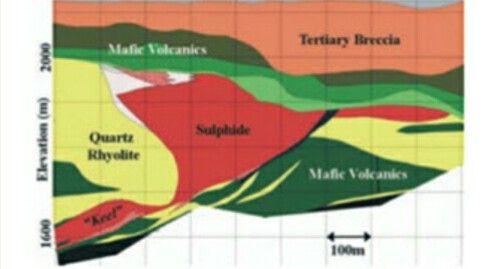
The global standard for the engineering logging and classification of overburden soils is the Unified Soils Classification System (USCS – ASTM D2487, Table 2.7). The basis of the system is that coarse-grained soils are logged according to their grain size distributions and fine-grained soils according to their plasticity. Thus, only grain size analyses and Atterburg Limits tests are needed to completely identify and classify a soil (Holtz & Kovacs 1981).
There are four major divisions in the USCS: coarse-grained, fine-grained, organic soils and peat. The classification is performed on material passing a 75 mm sieve, with the amount of oversize being noted on the drill log. Particles greater than 300 mm equivalent diameter are termed boulders, and material between the 300 mm and 75 mm sieves are termed cobbles. Coarse-grained soils are comprised of gravels (G) and sands (S) having 50% or more material retained on the No. 200 sieve. Fine-grained soils (silt, M, and clay, C) are those having more than 50% passing the No. 200 sieve. The highly organic soils and peat can generally be divided visually.
The gravel (G) and sand (S) groups are divided into four secondary groups (GW and SW; GP and SP; GM and SM; GC and SP) depending on grain size distribution and the nature of fines in the soils. Well-graded soils have a good representation of all particles sizes; poorly graded soils do not. The distinction can be made by plotting the grain size distribution curve and computing the coefficients of uniformity (Cu) and curvature (Cc) as defined in the upper right-hand side of Table 2.7. The GW and SW groups are well-graded gravels and sands with less then 5% passing the No. 200 sieve. The GP and SP groups are poorly graded gravels and sands with little or no non-plastic fines.
The particle size limits given above are those adopted by ASTM D2487, which is published in the USA. Different limits may be adopted in different countries. For example, the Australian Standard (AS 1726-1993) adopts different limits, which are 2–60 mm for gravel, 0.062 mm for sand and less than 0.06 mm for silt and clay. As 60 mm, 2 mm and 0.06 mm sieves are not normally used, the percentage passing these sizes must be identified from a laboratory test using regular sieve sizes.
The fine-grained soils are subdivided into silt (M) and clay (C) on the basis of their liquid limit and plasticity index. Fine-grained soils are silts if the liquid limit (LL) and plasiticity index (PI) plot below the A-line on the Casagrande (1948) plasticity chart in the lower right-hand side of Table 2.7. They are clays if the LL and PI values plot above the A-line. The distinction between silts and clays of high plasticity (MH, CH) and low plasticity (ML, CL) is set at a liquid limit of 50.
Coarse-grained soils with more than 12% passing the No. 200 sieve are classified as GM and SM if the fines are silty, and GC and SC if the fines are clayey. Soils with 5–12% fines are classed as borderline and have a dual symbol. The first part of the dual symbol indicates whether the soil is well-graded or poorly graded. The second part describes the nature of the fines. For example, SW-SC is a well-graded sand with some fines that plot above the A-line.
Fine-grained soils can also have dual symbols. The shaded zone on Table 2.2 is one example (CL-ML). It is also recommended that dual symbols (e.g CL-CH) be used if the LL and PI values fall near the A-line or near the LL = 50 line. Borderline symbols can also be used for soils with about 50% fines and coarse grained fractions (e.g.GC-CL).
Planning and scoping
Planning and scoping the objectives of the drill hole are the most important steps of the drilling investigation. There must be clear primary and secondary objectives to extract the maximum amount of potential information. For example, geotechnical data collection may be the primary objective of the hole, but at the same time.
Downvoting a post can decrease pending rewards and make it less visible. Common reasons:
Submit
WARNING - The message you received from @carlos-ignacio is a CONFIRMED SCAM!
DO NOT FOLLOW any instruction and DO NOT CLICK on any link in the comment!
For more information, read this post: https://steemit.com/steemit/@arcange/phishing-site-reported-autosteem-dot-info
Please consider to upvote this warning if you find my work to protect you and the platform valuable. Your support is welcome!
Downvoting a post can decrease pending rewards and make it less visible. Common reasons:
Submit